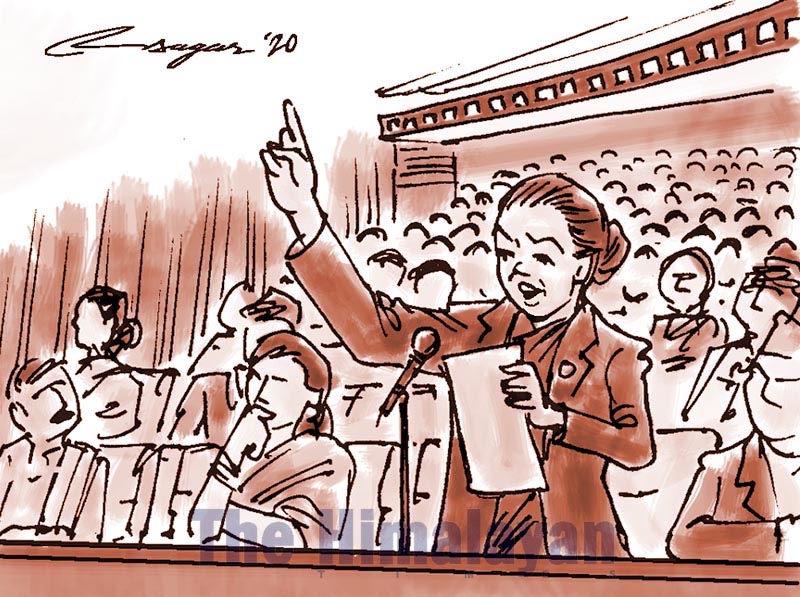Women’s status: Figures speak for themselves
Just marking International Women’s Day will never bring substantive changes in the real life of women in society. Rather, women activists must hold serious discussion with the state agencies to improve the feeble position of women
Along with the world, Nepal also marked International Women’s Day 2020. In Nepal, this special day of marking ‘Women’s Day’ has a long history of almost four decades. March 8 was first marked in 2017 BS. In 2033 BS, a few royalist women had celebrated it as ‘International Women’s Day’.
In 2046 BS, more than two dozen women protesters had sacrificed their lives during protests, consequently Nepali women had marked the 80th Women’s Day as a massive movement throughout the nation. The movement had played a pivotal role in ending the partyless Panchayat system and ushering multiparty democracy into the country. However, no substantive achievements could be secured by Nepali women in the constitution drafted after the movement. So the women’s movement got continued.
Now, it has become customary for all women in the world to mark March 8 as International Women’s Day every year. Article 38 of the Constitution of Nepal has guaranteed the fundamental rights of women. Similarly, Nepal, as a member state of the United Nations, has ratified various international human rights treaties and conventions related to women’s rights, which have explicitly pledged commitment towards protecting and promoting them. Amid all the constitutional and international treaties Nepal has adopted, it might be worth shedding some light on the real picture of women in Nepal. Let’s begin with a couple of cases which had jolted the nation.
First, on July 27, 2018, Nirmala Panta, a 13-year-old girl from Kanchanpur district in far west Nepal, was found raped and murdered in a sugarcane field. Then on September 6, 2019, 15-year-old Muskan Khatun sustained acid burns on her face allegedly thrown by two persons in Birgunj. These two are mere representative cases, which depict the real picture of women in Nepal and how insecure they feel in the country.
In the above mentioned crimes against women, the alleged culprits have still not been booked.
It can be argued that such heinous crimes have gone unpunished due to loopholes in our legal and justice mechanism. Our law enforcement agencies seem to be unable to act in time to avoid such incidents. As in many similar cases in the past, they have exposed the inherent weaknesses in our legal system, where the victim is made to suffer for life, while the perpetrators walk around free with no feeling of remorse whatsoever.
Just a few weeks ago, Informal Sector Service Center (INSEC), a human rights organisation of Nepal, published a report that claimed violence against women had increased in 2019 compared to the previous year. INSEC had documented 2,824 cases of violence against women in 2018, which shot up to 3,360 in 2019. Alarmingly, the number of rape cases went up from 475 to 530. Such figures compel one to ponder over the functioning mechanism of the state.
As we mark 110th International Women’s Day, it is also time to bring the status of women in the different apparatuses of Nepal to light. In politics, too, the participation of women is painfully low. There are altogether 78 ministers in both the federal and provincial governments. Out of them, only 11 are women. In the House of Representatives, out of the 275 parliamentarians, women’s representation stands at 90. Only six women have been elected while 86 have been nominated through the proportional system.
Representation of women in the province assemblies is also pathetic. In all the seven provinces, there are 550 members in the provincial assemblies, with only 89 women. More importantly, out of the 89 women, only 17 were elected. Similarly, the position of women’s representation at the local level is not satisfactory. Out of the 35,041 representatives, women constitute 14,353. Nepal’s constitution guarantees women’s representation of up to 33 per cent. However, whatever representation we are witnessing seems to have been possible due to the constitutional obligation. Otherwise, the patriarchal mindset dominating the Nepali society could not have allowed even the above achievement.
The situation of women is also dismal in the judiciary. Only three judges are women out of the 21 in the Apex Court of Nepal. In the High Courts, there are only eight women judges out of 257 seats. And out of 420 senior advocates, only 28 are women. In Nepal, we have the Nepal Police, Armed Police Force and Nepali Army. In these three security mechanisms, out of the 220,000 security forces, only 15,000 are from the women cluster.
I have plotted these figures to unmask the real face of women’s status in Nepal. Importantly, the cause behind the vulnerable position of women needs to be brought out on the table for discussion throughout the nation. Just marking International Women’s Day will never bring substantive changes in the real life of women in society. Rather, women activists must hold serious discussion with the state agencies to improve the feeble position of women.
Last but not the least, the patriarchal society and economic dependency on men are the grounds that lead to male domination in the society. But I can say, all that women need are just protection and opportunities. It is worth quoting here Margaret Thatcher, who said, “If you want something said, ask a man; if you want something done, ask a woman.”
Chaudhary is a member of Parliament






